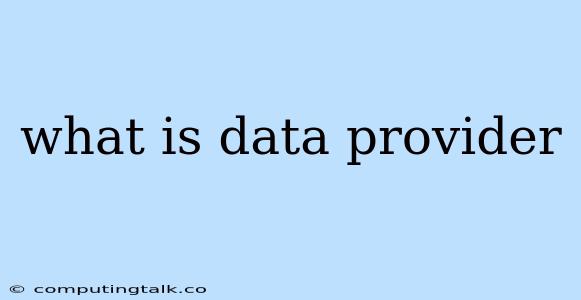A data provider is a crucial component in software development, acting as a bridge between your application and the source of data it needs to function. In essence, it's a mechanism that fetches data from various sources, processes it, and presents it in a format that your application can readily use. Let's delve into the specifics of what a data provider is and why it plays such a vital role in modern software applications.
Understanding the Role of a Data Provider
Think of a data provider as a dedicated data concierge. Your application has requests, and the data provider fulfills these requests by retrieving the necessary information from different sources, like databases, APIs, or even flat files. This retrieval process is often streamlined and optimized for efficiency, ensuring your application doesn't have to deal with the complexities of directly accessing and processing data.
Why Are Data Providers So Important?
Data providers bring several key benefits to the table, making them indispensable for developers:
1. Abstraction: Data providers act as an abstraction layer, shielding your application from the intricacies of how data is actually stored or accessed. This allows developers to focus on building the core functionalities of the application without getting bogged down in data-specific complexities.
2. Flexibility: Data providers are designed to be flexible. They can interact with a wide range of data sources, from traditional relational databases to modern cloud-based data stores, allowing you to integrate your application with different data platforms.
3. Reusability: Data providers are often designed to be reusable components. This means you can leverage the same data provider across multiple parts of your application or even in different applications, promoting code efficiency and reducing development time.
4. Data Transformation: Data providers can perform data transformations, converting raw data from its original format into a format that's suitable for your application's needs. This can involve tasks like data cleaning, filtering, and aggregation, enhancing the usability and relevance of the data.
5. Error Handling and Resilience: Data providers typically incorporate error handling mechanisms, ensuring your application can gracefully deal with situations like network outages or database errors. This robustness is crucial for maintaining the stability and responsiveness of your software.
How Data Providers Work
Data providers operate on a fundamental principle: they expose an interface that allows your application to request data. This interface might come in various forms, such as:
- Functions: Data providers can expose functions that accept parameters to specify what data is required and return the requested data.
- Objects: Data providers can be implemented as objects with specific methods for fetching data, updating data, and performing other operations.
Once a request is made, the data provider performs the following steps:
- Source Identification: The data provider determines the source of the requested data based on the request parameters.
- Data Retrieval: The data provider retrieves the data from the designated source, potentially performing data transformations or aggregations along the way.
- Data Delivery: The retrieved and processed data is delivered to the requesting component of your application.
Types of Data Providers
Data providers can be categorized based on their primary function or the data sources they access. Here are a few common types:
- Database Data Providers: These providers interact with relational databases like MySQL, PostgreSQL, or Oracle. They handle database queries, data manipulation, and transaction management.
- API Data Providers: API providers fetch data from external APIs, allowing your application to access data from other services or platforms. This is common for integrating with social media, weather services, or payment gateways.
- File-Based Data Providers: These providers read and process data from files, including CSV, XML, or JSON files. They can be useful for loading data from local storage or external sources like a website.
Examples of Data Providers
Several popular frameworks and libraries provide data provider functionalities:
- React Query: This library for React applications offers efficient data fetching and caching capabilities, simplifying state management and enhancing performance.
- Angular's HttpClient: Angular's built-in HttpClient service simplifies interactions with web APIs, making it easier to fetch and process data from external services.
- Django ORM: Django's Object-Relational Mapper (ORM) acts as a data provider, abstracting database operations and allowing you to work with database tables as Python objects.
Implementing a Data Provider
Let's illustrate how you might create a simple data provider in Python:
class ProductDataProvider:
def __init__(self, data_source):
self.data_source = data_source
def get_product_by_id(self, product_id):
# Simulate fetching data from the data source
product_data = self.data_source.get(product_id)
# Perform optional data transformation here
return product_data
In this example, the ProductDataProvider class acts as a data provider. It initializes with a data_source (which could be a dictionary, database connection, or an API client) and provides a method get_product_by_id to retrieve product data.
Choosing the Right Data Provider
Selecting the most appropriate data provider depends on the specific needs of your application:
- Data Source: The type of data source (database, API, files) you need to access will guide your choice of data provider.
- Complexity: The complexity of data operations (simple retrieval, advanced filtering, real-time updates) will influence the data provider's features.
- Performance Requirements: The performance requirements of your application (data volume, speed of retrieval) should factor into your selection.
- Ecosystem Compatibility: Choose a data provider compatible with your existing framework or library to ensure seamless integration.
Conclusion
Data providers are fundamental to modern software development, enabling applications to access and utilize data efficiently. By abstracting data sources, offering flexibility, and enhancing reusability, they simplify the process of interacting with data, allowing developers to focus on building powerful and engaging software solutions. Understanding the role of data providers is crucial for building robust, scalable, and data-driven applications.
